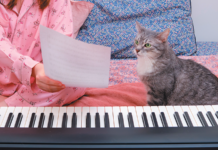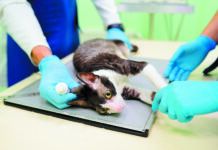[From Tufts January 2010 Issue]
My cat plays rough. I have limited recent experience with cats. I adopted Grigino, my personable 2-year-old cat, when he was 2 months old. Every once in a while he tries to gently bite my hand. When he does this, he will hit at the hand with his paw, probably to control the hand or line it up, before he bites at it. Fortunately, he never bites hard, and almost always retracts his claws. However, he does occasionally draw blood. He is neutered. Should I be concerned and how can I break him of this habit?
Al Cavagnaro
Dear Al: I suspect that Grigino is exhibiting owner-directed play aggression. It is important to remember that play, including play aggression, is a natural behavior for kittens during which they develop motor skills and rehearse fighting and predatory skills. Viewing your cat’s behavior in this light may help you be less fearful of your young feline companion.
However, bites, even if executed during play, can be disconcerting and painful. Play aggression often begins when a kitten is about 4 months of age and usually disappears when the cat turns 1 so Grigino should have begun to settle down by now.
There are many triggers for play aggression, but the two most common are insufficient play time to release pent-up energy and petting beyond a cat’s tolerance level. Play aggression usually takes two forms: attack-and-retreat and the ambush. The attack-and-retreat type mimics actual fighting and is often triggered by petting. The ambush type resembles predatory behavior and is often triggered by moving feet or dangling or tapping fingers.
Grigino should not be allowed to direct play-aggressive tactics toward you as this may teach him that he can control you by using aggression. Avoid play aggression by learning to read your cat’s body language indicating that he is about to launch another attack. Dilated pupils, a swishing tail — especially during petting — and tense body language are indicators that you should stop petting Grigino and, if safe to do so, quietly stand up.
If you notice that Grigino is crouched and perhaps treading with his hind feet preparing for an ambush attack, divert his attention to another target by tossing a toy or paper wad. Prevent attacks by engaging him in daily interactive play with moving toys, such as feather wands which you can wave so that he attacks the feathers and not you. A play session should include a “cool down” period at the end where you move the toy more slowly so Grigino can calm down.
Avoid physically punishing Grigino and avoid having a big reaction to his aggressive behavior as this could increase his arousal levels and trigger another play assault. He’ll just figure that you like to play rough. Finally, be patient. Grigino is maturing and episodes of play aggression should continue to decrease as he ages.
With patience, sensible precautions and purposeful play sessions, I am confident that you and Grigino can spend many years together as close companions.
Alice Moon-Fanelli, PhD
Certified-applied animal behaviorist



